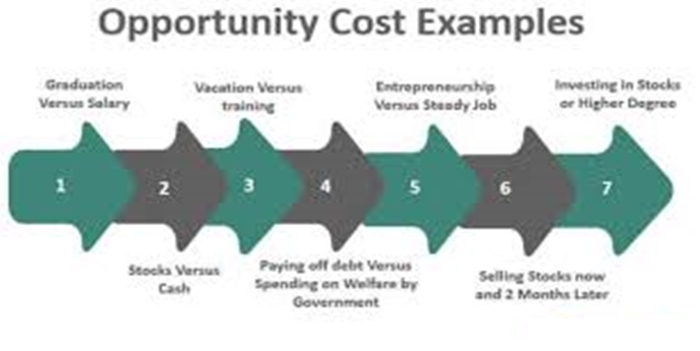Introduction
Opportunity cost represents the value of the next best alternative that is forgone when a decision is made. It essentially means what you give up when you choose one option over another. Recognizing opportunity cost is crucial for making informed decisions, both in personal life and business, as it highlights the trade-offs inherent in every choice. In this article, we define opportunity cost, the examples, and the challenges.
Definition
Opportunity cost refers to what you have to give up to buy what you want in terms of other goods or services. When economists use the word cost, we usually mean opportunity cost. The word “cost” is commonly used in daily speech or in the news.
Opportunity cost is not just monetary, it can also involve time, convenience, satisfaction, or other resources.
It’s about relative cost, not absolute price.
Understanding Opportunity Cost with Real-World Examples:
- Personal Decisions
These are the most relatable and frequent examples of opportunity cost.
Going to College vs. Starting Work Immediately:
Choice: Attend a four-year university.
Explicit Costs: Tuition, fees, books, living expenses.
Choice: Buy a new, expensive smartphone.
Explicit Cost: The price of the phone.
The potential interest or investment returns you could have earned if you had saved or invested that money instead. Over time, seemingly small daily purchases (like a fancy coffee) can have a significant opportunity cost when compounded.
Opportunity Cost: The time you could have spent exercising, socializing with friends, working on a hobby, learning a new skill, or doing household chores. Each activity has a distinct value that you forgo.
Dietary Choices:
Choice: Eating a large, unhealthy meal for immediate gratification.
Opportunity Cost: The long-term health benefits of a more nutritious meal, potentially more energy, better digestion, and reduced risk of health issues.
Commuting Choices:
Explicit Costs: Fuel, maintenance, parking.
Opportunity Cost: The time you could have used on public transport (e.g., reading a book, working), the money saved on fuel and parking if you took a bus, or the health benefits of cycling.
- Business Decisions
Businesses constantly face choices about how to allocate their limited capital, labor, and time to maximize profits.
Investing in New Equipment vs. Marketing Campaign:
Choice: A manufacturing company invests in new, automated machinery.
Opportunity Cost: The potential increase in sales and brand awareness that could have resulted from a significant marketing campaign, or the returns from investing that capital in a different project.
Expanding into a New Market vs. Consolidating Existing Operations:
Choice: A restaurant chain expands into a new city.
Opportunity Cost: The potential to improve efficiency, reduce costs, or enhance customer experience in its existing locations by focusing resources there.
- Government and Public Policy Decisions
Governments, with their finite budgets and resources, continually make decisions that involve significant impacting entire societies.
Healthcare vs. Education Spending:
Choice: A government allocates a larger portion of its budget to building new hospitals and improving healthcare services.
The potential improvements in educational outcomes, infrastructure development, or environmental protection that could have been achieved with those same funds. Every Naira spent on one sector cannot be spent on another.
The Challenge of Recognizing Opportunity Cost:
While the concept is straightforward, recognizing and calculating opportunity cost can be challenging because:
It’s often implicit: Unlike explicit costs (like a price tag), opportunity costs are not always obvious or easily quantifiable. How do you quantify the lost enjoyment of an evening with friends or the value of reduced stress?
Cognitive Biases: Humans are prone to biases like “sunk cost fallacy” (continuing an activity because of past investment, ignoring future opportunity costs) or “present bias” (prioritizing immediate gratification over long-term benefits).
Future Uncertainty: the costs often involve future potential benefits that are uncertain and require foresight.
Conclusion
Opportunity cost is everywhere. Whether you’re deciding how to spend your time, money, or energy, understanding what you’re giving up helps you make more informed and rational decisions. It’s not about making perfect choices, it’s about being conscious of trade -offs.
READ: The Growth of E-commerce


